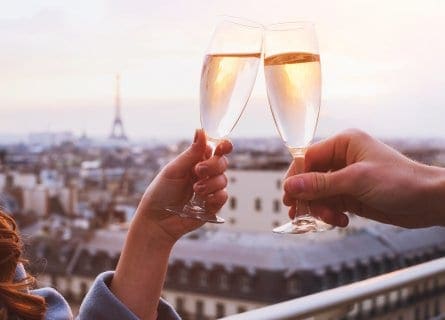
Bordeaux Travel Guide
Bordeaux Unbottled: World-Class Wines and Waterfront Wonders
Built on a curve of the Garonne River, Bordeaux has been an important port since pre-Roman times and, for centuries, a focus and crossroads of European trade. Today, it is the world’s largest fine wine region and, for its red wines, undoubtedly the most familiar outside France. The export of wine has always been the basis of the city’s wealth and prosperity, and today, the Bordeaux region produces over 44 million cases of wine each year.
Bordeaux’s history begins around 300 BC, when the Celtic tribe, the Bituriges Vivisci, founded what was then known as Burdigala. Interestingly, the name Bourde is still the name of a river south of the city. The settlement prospered until Julius Caesar came knocking in 60 BC. His conquest of Gaul (France) brought Bordeaux into the limelight for the Roman Empire, as it later became the capital of Roman Aquitaine. We also have the Romans to thank for the fabulous wines that Bordeaux produces today, as its wine history seems to have begun sometime after 43 AD when the Romans established vineyards to cultivate wine for their soldiers.
Like so many cities under Roman control, Bordeaux was visited by invaders on more than one occasion. In 276 AD, it was sacked by the Vandals. They attacked again in 409 AD, the Visigoths paid a visit in 414 AD, and the Franks paid their respects in 498 AD, signifying the beginning of dark times for the city. Bordeaux survived, however, and emerged in a stronger position than before in the late 6th century. It became the seat of the county and a mini-kingdom within the Merovingian kingdom of the Franks.
The good times sadly did not last, and the city fell into obscurity as the Frankish Kingdom collapsed in southern Gaul in the late 7th century. Invaders again visited Bordeaux; this time, the troops of Abd er Rahman in 732 ravaged the once prosperous city. Rahman was subsequently killed during the Battle of Tours later that year. Bordeaux then came under the control of the Carolingians, who appointed a series of Counts of Bordeaux who served to defend the mouth of the Garonne River from the Vikings hordes. They did a pretty decent job. Eventually, the Dukes of Gascony inherited the city in the late 10th century, and a golden era would dawn.
From the 12th to the 15th century, Bordeaux regained importance and enjoyed some good times following the marriage of Duchess Eleanor of Aquitaine with the French-speaking Count Henri Plantagenet, who became King Henry II of England within months of their wedding. The city prospered, mainly due to the wine trade, and the cathedral of St. André was built.
Bordeaux remained an independent state under Prince Edward, known as the Black Prince in the 14th century, but in the end, after the Battle of Castillon in 1453 AD, it was annexed by France, which extended its territory. The 100-year War with the English effectively ended the wine trade with a major consumer, and the city lost a good deal of its wealth. The Château Trompette (Trumpet Castle) and the Fort du Hâ, built by Charles VII of France, were the symbols of the new domination, reminding the citizen who was boss!
The city regained its importance in the 16th century when it became the center of the distribution of sugar and slaves from the West Indies, along with the wines that the Dutch, English, and Germans had developed such a taste for. It was officially annexed to the Kingdom of France in 1653 when the army of Louis XIV entered the city and claimed it as their own. Bordeaux enjoyed a relatively quiet time until the 18th century, when a new golden age entered, and the city prospered again.
The foundations for this great era were laid in the late 17th century when Dutch traders began to drain the marshland around the Médoc and encouraged the planting of vineyards. The Dutch would also open new distribution channels to the Bourgeois, which helped usher in a second era of prosperity. However, the War of the Spanish Succession broke out in the early 18th century, which made navigation along the French coastline and the English Channel very risky. You have to admire the resolve of the Bordeaux Château and Merchants, who managed to ship their wines to markets such as London despite the wartime politics of the period.
Many famous buildings and monuments, including those on the quays, were built in this period. The famous French writer Victor Hugo found the town so beautiful that he once said: “Take Versailles, add Antwerp, and you have Bordeaux.” Baron Haussmann, a long-time prefect of Bordeaux, used Bordeaux’s 18th-century big-scale rebuilding as a model when Emperor Napoleon III asked him to transform Paris into a “modern” capital that would make France proud. It was a great time to call yourself a Bordeaux citizen.
The city enjoyed a relatively stable and prosperous existence until the outbreak of the First World War in 1914. Bordeaux escaped reasonably unscathed from the conflict; the French government even relocated from Paris to Bordeaux briefly during the beginning of the War. The same thing happened during World War II when it became apparent that Paris would soon fall into German hands. The Nazis enjoyed the Bordeaux wines very much; Commander-in-Chief Hermann Göring even took control of the Château Mouton Rothschild, which served as a military headquarters and continued producing wine throughout the War.
Bordeaux also served as a base for Italian Royal Navy submarines and a major base for German U-boats as headquarters of the 12th fleet. The massive, concrete U-boat pens have proved impractical to demolish and are now partly used as a cultural center for exhibitions. This is a great example of this city using its darker times to its advantage.
The city has continued upward since the 1940s and has always welcomed visitors worldwide for its wonderful wine, rich history, and beautiful countryside. Whether you prefer to leisurely explore its great stately Château at your leisure, explore the UNESCO World Heritage center or are drawn to more active pursuits such as horse riding or sailing, the region is home to a range of interests and wines which suit all tastes and pockets. You will be fascinated and delighted no matter where you start or finish. Now, let’s crack open some good Bordeaux!
-

Oysters from nearby Arcachon Gastronomy & Wine
Two things that the French take very seriously indeed are food and wine, and the citizens of Bordeaux are no exception. The Bordelais are very serious about Gastronomy. They love their food almost as much as their wine and have developed some superb dishes to accompany them. For the dry whites from the Graves region, there are oysters from the beds in the bay of Arcachon, tiny shrimps, and grilled sea bass or other locally caught fish. You can also try the local delicacy- eel for those daring enough. The tender-fleshed Pauillac lamb that used to be reared on the salt marshes at the edges of the estuary is very much on the menu, perfectly matched by Bordeaux red wines. In Bordeaux, you will find a traditional emphasis on fresh, local produce and rich sauces; butter and cream feature heavily!
Bordeaux is full of good restaurants around the old town; L’Orleans Brasserie is our favorite, serving divine entrecote a la Bordelaise – a large piece of beef served with a red wine sauce. The entire region has about 116,160 hectares of vineyards, 57 appellations, 10,000 wine-producing châteaux, and an annual production of approximately 850 million bottles. So there is sure to be something to please everyone! Delicious, complex, and elegant reds and whites are the mainstays, with some exquisite dessert wines from Sauternes designed for Foie Gras. Indeed, it is a gastronomic paradise.
A Gastronomic Guide to the Cuisine of Bordeaux: Read more
Nearby Wine Regions
-
 Explore Bordeaux! Left Bank Cabernets, Right Bank Merlots. Find your dream bottle & plan your next tour! (with 2024 insights) Read more
Explore Bordeaux! Left Bank Cabernets, Right Bank Merlots. Find your dream bottle & plan your next tour! (with 2024 insights) Read more
Highlights
-
Basilique St-Michel
Bordeaux’s most famous monument is the magnificent Basilique St-Michel, begun in 1350. It took 200 years to complete and it is stunningly beautiful, worth the wait. The 18th century Grand Theatre, a great example of French Neoclassical style is also worth a visit.
-
Saint-Emilion Cathedral
Everyone who comes to Bordeaux should visit the village of Saint-Emilion, the prettiest of all Bordeaux’s regions. The village is full of underground churches and catacombs that have been carved out of the limestone rock. On one of our private tours, your guide will explain how this underground area has developed over the centuries underneath the village, culminating in the massive monolithic cathedral, started by an order of monks in the 8th century.
Recommended for you
More information
If you would like us to customize an exclusive luxury tour, contact us and let us know your travel plans. We offer luxury food and wine tours for private groups of a mininium two guests. In addition, all of our private, chauffeured tours are available year-round upon request.














